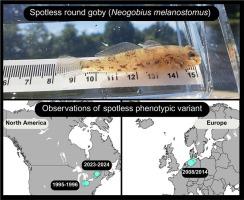Spotless round gobies: A poorly described phenotype of Neogobius melanostomus
IF 2.5
3区 环境科学与生态学
Q3 ENVIRONMENTAL SCIENCES
引用次数: 0
Abstract
The round goby (Neogobius melanostomus) is a widely distributed invasive fish, typically distinguished from morphologically similar native species by a prominent black spot on the first dorsal fin. Although spotless individuals have been reported, their prevalence and characteristics remain poorly documented. Spotless round gobies were discovered in the St. Lawrence and Richelieu rivers in Quebec, Canada. Mitochondrial DNA analysis confirmed their identity as N. melanostomus, indicating that the spotless form represents a phenotypic variant within the species. In both rivers, the frequency of this phenotype was found to be low, ranging from 0.18 to 1.14%, with no apparent association with sex and body length. To contextualize these findings, a literature review on this phenotype and its occurrence is presented. The existence of spotless round gobies may challenge public awareness and monitoring efforts, particularly those that rely on the presence of the typical dorsal spot for accurate species identification.

一尘不染的圆虾虎鱼:一种描述不佳的黑口新虾虎鱼的表型
圆虾虎鱼(Neogobius melanostomus)是一种分布广泛的入侵鱼类,与形态相似的本地物种的典型区别在于第一背鳍上有一个突出的黑点。尽管有报道称有无斑点的个体,但它们的流行和特征仍然缺乏文献记载。在加拿大魁北克省的圣劳伦斯河和黎塞留河发现了一尘不染的圆虾虎鱼。线粒体DNA分析证实了它们的身份是N. melanostomus,表明一尘不染的形式代表了物种内的表型变异。在这两条河流中,这种表型的出现频率较低,在0.18% ~ 1.14%之间,与性别和体长无明显关联。为了将这些发现联系起来,我们对这种表型及其发生进行了文献综述。毫无斑点的圆虾虎鱼的存在可能会挑战公众的意识和监测工作,特别是那些依赖于典型背斑的存在来准确识别物种的人。
本文章由计算机程序翻译,如有差异,请以英文原文为准。
求助全文
约1分钟内获得全文
求助全文
来源期刊

Journal of Great Lakes Research
生物-海洋与淡水生物学
CiteScore
5.10
自引率
13.60%
发文量
178
审稿时长
6 months
期刊介绍:
Published six times per year, the Journal of Great Lakes Research is multidisciplinary in its coverage, publishing manuscripts on a wide range of theoretical and applied topics in the natural science fields of biology, chemistry, physics, geology, as well as social sciences of the large lakes of the world and their watersheds. Large lakes generally are considered as those lakes which have a mean surface area of >500 km2 (see Herdendorf, C.E. 1982. Large lakes of the world. J. Great Lakes Res. 8:379-412, for examples), although smaller lakes may be considered, especially if they are very deep. We also welcome contributions on saline lakes and research on estuarine waters where the results have application to large lakes.
 求助内容:
求助内容: 应助结果提醒方式:
应助结果提醒方式:


